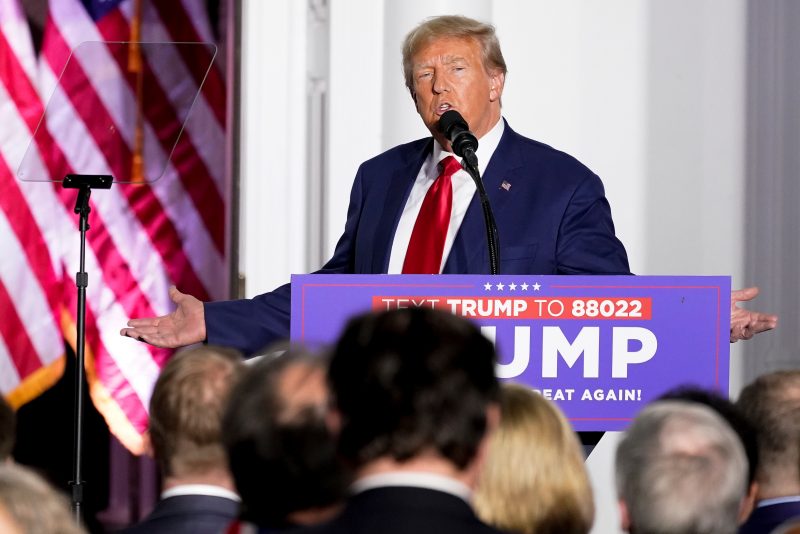Since the final weeks of the 2016 presidential campaign, Donald Trump has referred often to Hillary Clinton’s emails, but the references have increased in urgency and frequency as he continues to deploy them in response to special counsel Jack Smith’s investigation into his own handling of classified documents. He has posted comments on Truth Social at least seven times in the last three weeks, both before and after he was indicted on federal criminal charges that he repeatedly broke the law by hiding classified documents in his home.
Why wouldn’t “Deranged Jack Smith” look at “Hillary’s 33,000 emails that she deleted and acid washed,” he wrote in a post on June 13 and again on June 16. “CROOKED HILLARY DELETED 33,000 EMAILS, MANY CLASSIFIED, AND WASN’T EVEN CLOSE TO BEING CHARGED! ONLY TRUMP – THE GREATEST WITCH HUNT OF ALL TIME!” he posted on June 5. Trump’s allies have echoed the comparisons in hundreds of social media postings as they suggest there is a two-tiered justice system.
In a speech at his Bedminster, N.J., golf club the evening of his arraignment, Trump was more expansive, making many false claims about materials found on the private email server Clinton maintained as secretary of state. As usual, Trump mixes partial facts and invented assertions into a stew of false equivalence. Let’s try to untangle it.
“Hillary Clinton set up an illegal private server in her basement … with the deliberate intention of violating public information law so she could hide her pay-for-play scandals at the Clinton Foundations or whatever.”
This is fiction. FBI interviews revealed that the arrangement came about because Clinton, a technophobe who, according to aides, never learned how to use a desktop computer, did not want to give up her BlackBerry device. Her preference for a personal email account was not against the rules but it was discouraged.
At the same time, to the chagrin of other agencies in the U.S. government, the State Department before Clinton’s arrival had a lax security posture that often relied on unclassified email systems. As the Fact Checker disclosed in 2016, many intelligence officials believed there were serious shortcomings in how State handled sensitive communications.
There is no evidence of any “pay-for-play” scandal at the Clinton Foundation. The Washington Post in 2015 revealed that Bill Clinton was paid at least $26 million in speaking fees by companies and organizations that are also major donors to the foundation. Charity Navigator, which rates nonprofits, briefly put the Clinton Foundation, a large public charity, on its “watch list” because it had an “atypical business model” but then in 2016 rated it as of “low concern,” with a four-star rating, its highest.
By contrast, Trump in 2019 was ordered by a judge to pay $2 million for misusing funds in the tax-exempt Trump Foundation.
“Hillary stored vast quantities of classified and sensitive information on her illicit server.”
This is mostly false, especially with regard to classified information. (Trump also said there was “sensitive information” — a vaguer term that covers material that is not classified.) None of the more than 30,000 emails bore classification markings — in stark contrast to the documents found at Trump’s Mar-a-Lago estate, where many have clear markings indicating they contained highly sensitive classified information.
There has been some confusion over whether Clinton’s emails were marked classified because of a mistake made by FBI Director James B. Comey at his 2016 news conference announcing that Clinton would not be prosecuted. He said three emails “were classified at the time they were sent or received.” At the time, he said one was marked “secret” and two “confidential,” but at a congressional hearing two days later, he said all were marked “confidential,” the lowest form of classification. Moreover, he acknowledged that the markings — a (C) — were contained in the body of the text and, contrary to standard practice, there was no header at the top alerting the recipient that this was classified material. He told lawmakers that without a header, it was “a reasonable inference” that this material was not classified.
The emails concerned proposed talking points for Clinton when she called a foreign leader. The State Department later said the (C) markings should have been removed as a matter of course once Clinton decided to place the call, but through “human error,” they had not been deleted. In her FBI interview, Clinton said she did not know what (C) meant and “speculated it was a reference to paragraphs ranked in alphabetical order.” A nearly 600-page Justice Department inspector general report released in June 2018 said the FBI missed the (C) markings until late in the investigation.
Two further investigations of the Clinton emails conducted during the Trump administration — first when Rex Tillerson was secretary of state and then again when Mike Pompeo was the chief diplomat — confirmed that none of the emails had been marked classified.
Still, investigations determined that classified information sometimes seeped into email exchanges. In one instance, a State Department official forwarded a newspaper article; then in subsequent exchanges, aides revealed sensitive details of a secret program as they discussed the shortcomings of that public report. Ultimately, the email chain ended up in Clinton’s inbox.
But this was relatively rare. In all, 52 email chains were determined to contain classified information, Comey said.
The 2019 Pompeo report was critical of Clinton’s decision to have a private server — “it added an increased degree of risk of compromise as a private system lacks the network monitoring and intrusion detection capabilities of State Department networks.” But the report concluded: “Instances of classified information being deliberately transmitted via unclassified email were the rare exception and resulted in adjudicated security violations. There was no persuasive evidence of systemic, deliberate mishandling of classified information.”
Clinton herself was not found to “bear any individual culpability” for the classified leaks under investigation.
“Some of it happened to leak; it leaked into Anthony Weiner’s computer, remember Anthony Weiner, into his computer. You don’t want to be on his computer.”
Trump seizes on a discrete instance to suggest there was a wider leak of Clinton’s emails. Anthony Weiner, a former member of Congress, at the time was married to Huma Abedin, one of Clinton’s top staffers, and was under investigation for sexting with a 15-year-old girl. The FBI seized his laptop and discovered it also contained emails and BlackBerry messages between Clinton and Abedin.
The FBI identified 13 confirmed classified email chains that were duplicates of what it had also already examined in the Clinton investigation. None were marked classified at the time, but the FBI “determined that Abedin forwarded two of the confirmed classified emails to Weiner,” the IG report said.
There’s an irony to Trump’s decrying the “leak” of Clinton’s emails, because on the campaign trail in 2016 he regularly cited a different set of emails — from the Clinton campaign — that had been hacked by Russia operatives and then distributed by WikiLeaks.
“And all of it was illegal because thankfully she was never president. She didn’t have the powers to declassify.”
Clinton’s actions were not illegal, though ill advised. Trump tosses in a reference to the power of the president to declassify. One of his excuses for keeping the records that resulted in his indictment is that he wrongly claims that the material was declassified simply because he took the documents with him. There’s a formal process involved. (The indictment also cited an audio recording of Trump in July 2021 referring to a document he had retained that he claimed was “highly confidential” but he couldn’t share because he was no longer president and could not declassify it.)
“When caught, Hillary then deleted and acid washed. Nobody does that because of the expense.”
For some reason, Trump regularly says Clinton at great expense “acid washed” her emails. When Clinton staff asked an aide to delete about 30,000 personal emails before handing over work emails to the State Department, they were deleted with a free software program known as BleachBit; there is no such thing as “acid washed.”
“But it’s pretty conclusive, 33,000 emails in defiance of a congressional subpoena already launched. The subpoena was there and she decided to delete, acid wash, and then smash and destroy her cellphones with a hammer. And then they say, I participated in obstruction? No, think of it. That’s called obstruction. There’s never been obstruction as grave as that.”
This is false. Clinton’s staff had requested that the personal emails be deleted months before the subpoena, according to the FBI. Moreover, there’s no evidence Clinton deleted the emails in anticipation of the subpoena. Comey said his agency’s investigation found no evidence that any work-related emails were “intentionally deleted in an effort to conceal them.”
The FBI reported that a Clinton aide destroyed two old phones with a hammer — which is an effective way to prevent data from being assessed — but there is no indication this was done in response to a subpoena.
“The FBI and the DOJ protected her, did not issue subpoenas, did not use a grand jury, did not execute search warrants. And then, the corrupt head of the FBI, James Comey, declared, ‘No reasonable prosecutor would bring a case.’ Can you believe it?”
This is wrong. Investigators “sought to obtain evidence whenever possible through consent but also used compulsory process, including grand jury subpoenas, search warrants, and 2703(d) orders (court orders for non-content email information) to obtain various evidence,” according to the IG report. “We found that the prosecutors provided justifications for the preference for consent that were supported by Department and FBI policy and practice.”
Investigators did not require witnesses to testify before a grand jury and relied on voluntary witness interviews, including with Clinton. But the IG said “one of the reasons for not using the grand jury for testimony involved concerns about exposing grand jurors to classified information.” The IG added that allowing two fact witnesses to attend Clinton’s interview as her counsel was “inconsistent with typical investigative strategy” but the FBI “determined that the only way to exclude them was to subpoena Clinton to testify before the grand jury, an option that we found was not seriously considered” because the evidence did not support criminal charges and the interview was deemed unlikely to change the outcome.
“Hillary Clinton took hundreds of thousands of dollars’ worth of furniture, china, flatware, rugs and more from the White House and she wasn’t prosecuted. How about that one? She took the furniture and the china.”
Trump extended his comparison with Clinton in commenting more broadly on what she and her husband removed from the White House. He greatly exaggerated. When he left office, Bill Clinton reported that he had retained $190,027 worth of gifts that he had received. “Many of the gifts the Clintons are taking with them are from Hollywood figures, Democratic donors and a wide array of friends and associates, including his Georgetown University classmates,” The Post reported. The Clintons took about $21,800 worth of china, including gifts from actor-actress couple Ted Danson and Mary Steenburgen and movie director and producer Steven Spielberg and his wife, actress Kate Capshaw. Other gifts retained by the Clintons included artworks, flatware, furniture and rugs.
But then The Post revealed that some gifts were intended for the White House, not the Clintons. Within a week, the Clintons returned $28,500 in furnishings that The Post had identified as legally designated as White House property by the National Park Service. The Clintons also decided to pay for $86,000 worth of gifts given to them in 2000, given that Hillary Clinton had been elected a U.S. senator and thus became covered by strict ethics rules that prohibit the receipt of any gift (other than from relatives) worth more than $50.
Trump, by contrast, failed to report nearly $300,000 in gifts from foreign leaders, a report by House Democrats said this year. Two gifts, including golf clubs from the Japanese prime minister, cannot be found.
(About our rating scale)
Send us facts to check by filling out this form
Sign up for The Fact Checker weekly newsletter
The Fact Checker is a verified signatory to the International Fact-Checking Network code of principles



























